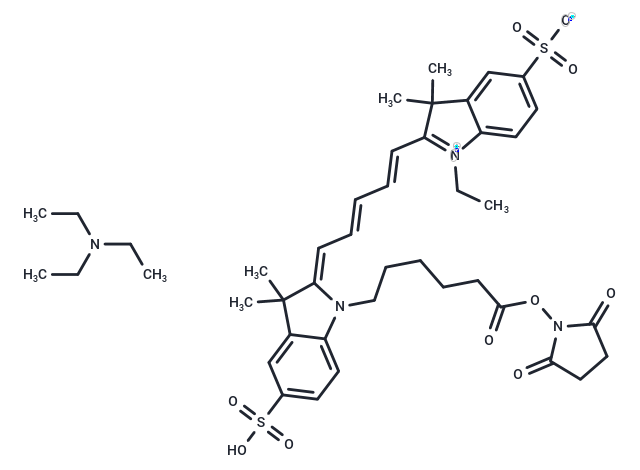Shopping Cart
Remove All Your shopping cart is currently empty
Your shopping cart is currently empty
CY5-SE triethylamine salt (Fluorolink Cy5 triethanolamine salt) is a hydrophilic amine-reactive fluorescent probe. It displays excitation/emission maxima of 646/662 nm, respectively. Cy5-SE-conjugated ligands have been used in the characterization of hematopoietic tumor microenvironments.

| Pack Size | Price | USA Warehouse | Global Warehouse | Quantity |
|---|---|---|---|---|
| 1 mg | $41 | - | In Stock | |
| 5 mg | $97 | - | In Stock | |
| 10 mg | $147 | - | In Stock | |
| 25 mg | $296 | - | In Stock | |
| 50 mg | Preferential | - | In Stock |
| Description | CY5-SE triethylamine salt (Fluorolink Cy5 triethanolamine salt) is a hydrophilic amine-reactive fluorescent probe. It displays excitation/emission maxima of 646/662 nm, respectively. Cy5-SE-conjugated ligands have been used in the characterization of hematopoietic tumor microenvironments. |
| Cell Research | Instructions I. Preparation of reagents 1. Preparation of mother solution: Use DMSO (or other appropriate solvents), the concentration can be adjusted according to experimental requirements, generally 1 mM. 2. Preparation of working solution: If it is needed for labeling, it can be diluted with PBS or other suitable buffer as needed. The working concentration is generally between 10–100 µM, and the specific concentration is adjusted according to the experimental design. II. Operation steps 1. Labeling process: 1) Labeling proteins, peptides or oligonucleotides: Mix CY5-SE with target molecules (such as proteins, peptides, oligonucleotides, etc.). At room temperature, the reaction generally takes 30 minutes to 1 hour. The reaction conditions can be carried out in a buffer with a pH value of 7-8. 2) Reaction conditions: CY5-SE reacts with the amino group of the target molecule (such as the amino group of amino acids, the amino group of peptide chains), so the target molecule should have an amino group available for reaction. 3) Removal of unreacted dye: After the reaction is completed, dialysis, gel filtration or ultrafiltration can be used to remove unbound dye. This ensures the purity of the labeling and reduces background fluorescence. 2. Fluorescence detection: 1) Fluorescence microscope or flow cytometer: The labeled samples can be detected by fluorescence microscope or flow cytometer, with an excitation wavelength of 649 nm and an emission wavelength of 670 nm. 2) Fluorescence intensity determination: The intensity of the fluorescence signal is proportional to the number of labeled molecules. By detecting the signal intensity, the target molecules can be quantitatively analyzed. 3. Data analysis: 1) Fluorescence quantitative analysis: According to the change in fluorescence intensity, the concentration of the target molecule can be calculated. The fluorescence intensity can be compared with the standard curve for further quantitative analysis. 2) Control group: The difference in fluorescence intensity between the control group and the experimental group helps to evaluate the effect of different treatment conditions on the labeling effect of the target molecule in the experiment. |
| Synonyms | Fluorolink Cy5 triethanolamine salt, Cy5-SE (triethylamine salt) |
| Molecular Weight | 855.07 |
| Formula | C43H58N4O10S2 |
| Cas No. | 1497420-70-8 |
| Smiles | CCN(CC)CC.CC[N+]1=C(\C=C\C=C\C=C2/N(CCCCCC(=O)ON3C(=O)CCC3=O)c3ccc(cc3C2(C)C)S(O)(=O)=O)C(C)(C)c2cc(ccc12)S([O-])(=O)=O |
| Relative Density. | no data available |
| Storage | keep away from direct sunlight,store at low temperature | Powder: -20°C for 3 years | In solvent: -80°C for 1 year | Shipping with blue ice/Shipping at ambient temperature. | ||||||||||||||||||||
| Solubility Information | DMSO: 10 mM, Sonication is recommended. | ||||||||||||||||||||
| In Vivo Formulation | 10% DMSO+90% Saline: 1 mg/mL (1.17 mM), Sonication is recommeded. Please add the solvents sequentially, clarifying the solution as much as possible before adding the next one. Dissolve by heating and/or sonication if necessary. Working solution is recommended to be prepared and used immediately. The formulation provided above is for reference purposes only. In vivo formulations may vary and should be modified based on specific experimental conditions. | ||||||||||||||||||||
Solution Preparation Table | |||||||||||||||||||||
DMSO
| |||||||||||||||||||||
| Size | Quantity | Unit Price | Amount | Operation |
|---|

Copyright © 2015-2026 TargetMol Chemicals Inc. All Rights Reserved.